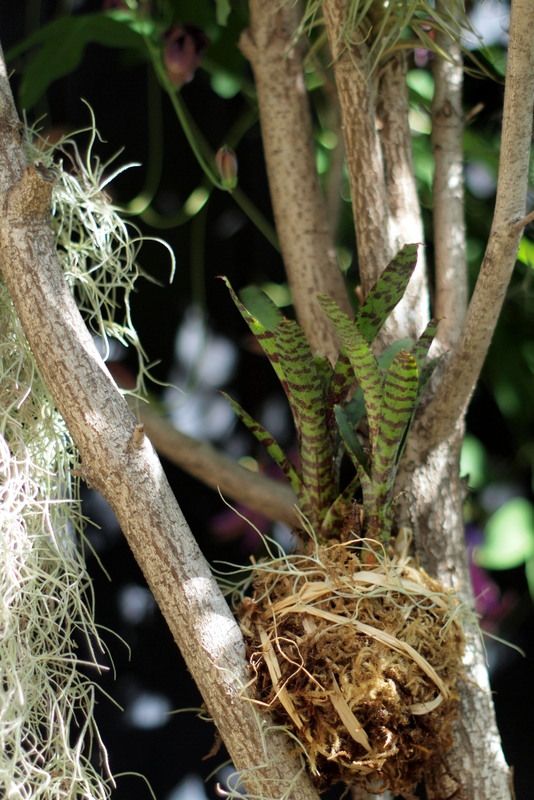If you keep up with just a few design blogs, there’s probably no need to explain kokedama, or Japanese mossed bonsai strung up like plant puppets, which I posted about here. Those expert creations involve carefully calibrating a plant’s light and soil needs, not to mention expert wrapping, packing, and tying skills. (Design Sponge has provided a good tutorial.) The ethereal effect of tightly wound, dangling orbs bursting with plants is so compelling that I might actually get around to trying it one day.

But if, like me, you have no tolerance, time, or the requisite fine motor skills for the expert stuff, or if your attention span this busy spring is in tatters, may I suggest joining me in an experimental alternative: Grab a small bromeliad, wrap some green moss around the roots including some of the coarse growing medium it came potted in, tie with raffia, and take advantage of the nooks of trees to wedge in the bastardized kokedama. From conception to wedging, it took me about 15 minutes since I had the green moss and raffia ribbon on hand. Being plant savvy, we know that bromeliads don’t really need a ball of soil to thrive and always appreciate the dappled light shade under a tree and the humid proximity of other growing things. This is basically how many bromeliads grow in the wild anyway, epiphytic, in the crotch of trees. The pittosporum shrub I limbed up (meaning removed its lower branches so it graduated from shrub to small tree) has become the perfect armature for hanging Spanish moss and other tillandsias, and now the little bromeliad kokedama. And the spring plant shows are the best hunting ground for small, affordable bromeliads. The trick is to know when to stop. A gaudy, Southern Gothic effect can take over really fast. Not that that’s a bad thing.

Where bromeliads have to stay indoors for winter, this would be a nice summer vacation home. The raffia ribbon works fine for bromeliads that will be wedged into branches. Twine or cotton thread might be a better choice for strength if it is to hang. My bromeliad is Neoregelia ‘Punctatissima Rubra’ x ‘Tigrina,’ grown more for its leaves than flowers. I’ll be misting the moss when I mist the tillandsias, about once a week, and will make sure that the bromeliad’s central cups stay filled with water. If mossing a dwarf olive tree seems out of reach, try practicing kokedama on tough, forgiving bromeliads.

Love it, gotta try it. I think Clifford (the big leaf magnolia) would look splendid sporting a few bromeliads for the summer.
Loree, I think so too — and no need to identify Clifford (or Sammy).